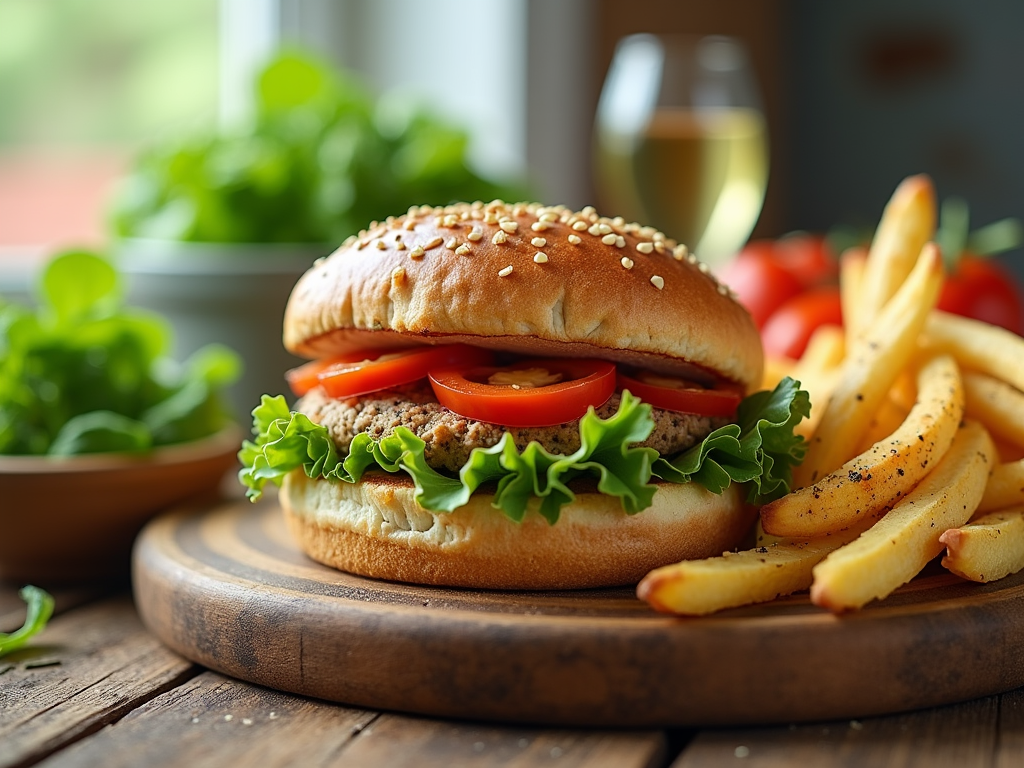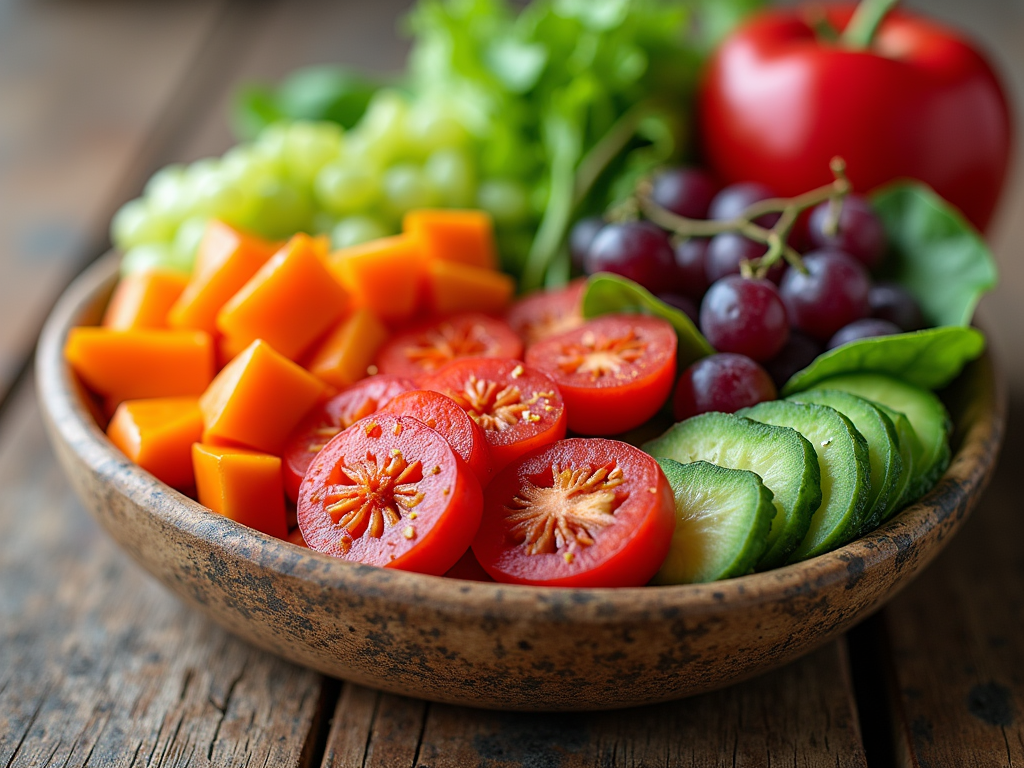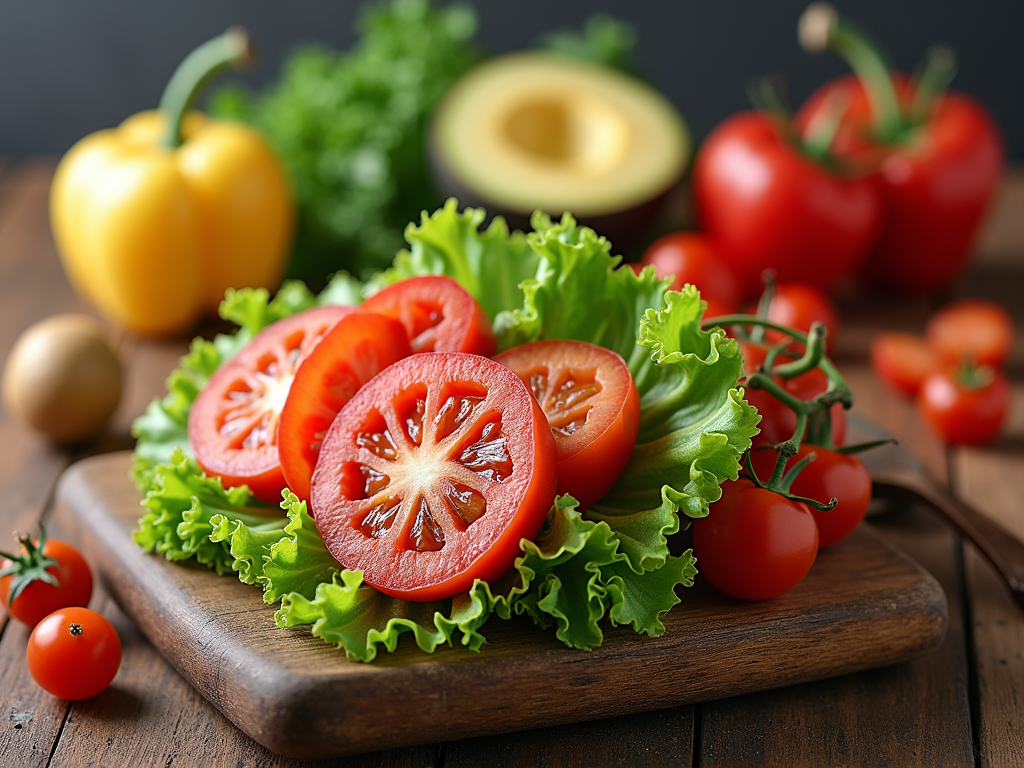I. Introduction
“`html
Are you looking to improve your overall health and well-being? One of the most effective ways to do this is by adopting healthy eating habits. A balanced diet is essential for providing your body with the necessary nutrients, vitamins, and minerals it needs to function properly. In this post, we will explore some valuable tips for maintaining a balanced diet that can help you achieve optimal health.
First and foremost, it’s crucial to understand what constitutes a balanced diet. A balanced diet typically includes a variety of foods from all food groups such as fruits, vegetables, whole grains, lean proteins, and healthy fats. Here are some key components:
- Fruits and Vegetables: These are rich in vitamins, minerals, antioxidants, and fiber. Aim for at least five servings a day.
- Whole Grains: Whole grains like brown rice, quinoa, and whole-wheat bread provide sustained energy and fiber.
- Lean Proteins: Include lean proteins such as chicken breast, fish (like salmon), tofu, and legumes in your meals.
- Healthy Fats: Nuts like almonds or walnuts along with seeds like chia or flaxseed are excellent sources of healthy fats.
Now let’s dive into some actionable tips for maintaining a balanced diet:
- Plan Your Meals: Create a meal plan that includes all food groups to ensure you’re getting everything you need.
- Shop Smart: Visit local farmers’ markets or grocery stores that offer organic produce options.
- Cook at Home: Cooking at home allows you more control over ingredients used in meals.
- Limit Processed Foods: Processed foods often contain high amounts of sugar, salt, and unhealthy fats; try to limit them in your diet.
- Stay Hydrated: Drink plenty of water throughout the day; it helps flush out toxins from the body.
Another important aspect is portion control. Eating large portions can lead to consuming more calories than needed which may result in weight gain or other health issues like diabetes or heart disease. Here are some tips for portion control:
- Use Smaller Plates: Using smaller plates can help you gauge how much food is appropriate for a single serving.
- Measure Ingredients: Measure ingredients when cooking to ensure accurate portion sizes.
Lastly, don’t forget about the importance of regular physical activity alongside a balanced diet. Regular exercise helps burn off excess energy stored as fat while also improving overall fitness levels.
In conclusion, maintaining a balanced diet is not just about what you eat but also how much you eat and how often you eat it. By incorporating these tips for maintaining a balanced diet into your lifestyle routine, you’ll be well on your way towards achieving optimal health benefits.
Remember always consult with healthcare professionals before making significant changes to your diet or exercise routine.
“`
This HTML content includes various bolded keywords and phrases related to maintaining a balanced diet while providing a structured format with headings, paragraphs, lists, and bullet points for better readability
II. Hydration Essentials
A. Water Intake Recommendations
Staying hydrated is crucial for maintaining a balanced diet and overall health. The recommended daily water intake varies by age, sex, and activity level. Generally, adults should aim to drink at least eight cups (64 ounces) of water per day. However, this can vary significantly depending on individual factors such as climate, physical activity level, and specific dietary needs.
For example, athletes or individuals who engage in strenuous physical activity may need to consume more water to replenish lost fluids and electrolytes. On the other hand, older adults may require less water due to decreased physical activity and changes in body composition.
It’s also important to note that you can get some of your daily hydration needs from other fluids like milk, juice, and tea, as well as from foods that are high in water content such as fruits and vegetables.
B. Hydration in Different Stages of Life
Hydration needs change throughout different stages of life. Here are some specific considerations:
- Pregnancy: Pregnant women need to stay hydrated to support fetal growth and prevent complications like preeclampsia. Aim for an additional 8 ounces of water per day.
- Breastfeeding: Breastfeeding mothers need more fluids to produce milk. Aim for an additional 8 ounces of water per day.
- Older Adults: Older adults may experience decreased thirst sensation due to age-related changes in the body. Encourage them to drink water regularly throughout the day.
It’s essential to monitor urine output as a sign of proper hydration. If urine is dark yellow or you’re not urinating frequently enough, it may indicate inadequate hydration.
Daily Water Intake Recommendations
| Group | Recommended Daily Water Intake (Ounces) |
|---|---|
| Adults | 64 |
| Pregnant Women | 72 |
| Breastfeeding Women | 80 |
| Older Adults | 48-64 |
Tips for Maintaining a Balanced Diet
Maintaining a balanced diet is crucial for overall health and well-being. Here are some tips:
- Eat a Variety of Foods: Ensure your diet includes a variety of fruits, vegetables, whole grains, lean proteins, and healthy fats.
- Limit Processed Foods: Processed foods are often high in unhealthy fats, added sugars, and sodium. Opt for whole foods instead.
- Stay Hydrated: Drink plenty of water throughout the day to help with digestion and nutrient absorption.
- Watch Portion Sizes: Pay attention to serving sizes to avoid overeating or under-eating essential nutrients.
- Consult a Professional: If you’re unsure about your dietary needs or have specific health concerns, consult with a registered dietitian or healthcare provider.
For more detailed information on maintaining a balanced diet, visit Healthline’s guide on the topic.
By following these tips and staying hydrated, you can significantly improve your overall health and well-being.
Additional Considerations
Some additional considerations for maintaining proper hydration include:
- Electrolytes: Electrolytes like sodium, potassium, and magnesium play critical roles in hydration. Include electrolyte-rich foods like bananas (potassium), avocados (potassium), and nuts (magnesium) in your diet.
- Monitoring Urine Output: If urine is dark yellow or you’re not urinating frequently enough, it may indicate inadequate hydration.
- Environmental Factors: Climate and physical activity level can significantly impact hydration needs. For example, individuals living in hot climates may need more water due to increased fluid loss through sweating.
By understanding these factors and making informed choices about your diet and hydration habits, you can better support your overall health.

**”A balanced diet is like a well-tuned orchestra; every note must be in harmony.”** – **Dr. Elara Vex, Nutritionist**
III. Nutrient-Rich Foods
A. Fruits and Vegetables Importance
Fruits and vegetables are essential components of a balanced diet, providing a wealth of nutrients including vitamins, minerals, and antioxidants. Incorporating a variety of colorful fruits and vegetables into your daily meals can help maintain optimal health. For instance, berries are rich in antioxidants which can help protect against cell damage and reduce inflammation.
Here are some tips for maintaining a balanced diet with fruits and vegetables:
- Eat a rainbow: Include a variety of colorful fruits and vegetables in your diet to ensure you get a broad range of nutrients.
- Raw vs. cooked: Both raw and cooked options have their benefits; raw vegetables retain more vitamins while cooked ones are easier to digest.
- Seasonal choices: Opt for seasonal produce to ensure freshness and better nutritional value.
For example, leafy greens like kale and spinach are packed with iron, calcium, and vitamins A and K. These nutrients are crucial for maintaining healthy bones and preventing anemia.
Here’s a table showing some high-nutrient fruits and vegetables:
| Fruit/Vegetable | Nutrients |
|---|---|
| Blueberries | Vitamin C, Antioxidants |
| Broccoli | Vitamin C, Fiber, Vitamin K |
| Carrots | Vitamin A, Fiber |
B. Protein Sources for Muscle Health
Protein is essential for muscle health as it helps build and repair muscle tissue. Here are some high-protein foods that can be included in your diet:
- Lean meats: Chicken breast, turkey breast, lean beef
- Fish: Salmon, tuna, cod
- Dairy products: Greek yogurt, cottage cheese, milk
- Legumes: Lentils, chickpeas, black beans
Here’s a list of tips for incorporating protein-rich foods into your diet:
- Start your day with protein: Begin your day with a protein-rich breakfast such as eggs or Greek yogurt to keep you full until lunchtime.
- Incorporate plant-based options: Legumes are not only high in protein but also rich in fiber which can help lower cholesterol levels.
- Choose lean cuts of meat: Opt for lean cuts of meat like chicken breast or turkey breast to reduce saturated fat intake.
For example, protein-rich foods like salmon are not only high in protein but also contain omega-3 fatty acids which are beneficial for heart health.
Here’s a table showing some high-protein foods:
| Food | Protein Content per Serving |
|---|---|
| Chicken Breast | 30 grams per 3 oz serving |
| Salmon | 20 grams per 3 oz serving |
| Lentils | 18 grams per cup cooked |
By incorporating these nutrient-rich foods into your diet and following these tips for maintaining a balanced diet, you can ensure you’re getting all the necessary nutrients for optimal health.

**”A balanced diet is like a well-tuned engine; it requires the right mix of nutrients to run smoothly.”** – **Dr. Elara Vex, Nutritionist**
IV. Meal Planning Strategies
A. Balanced Meal Composition
When it comes to maintaining a balanced diet, one of the most crucial aspects is ensuring that each meal is composed of all essential nutrients. A balanced meal should include a variety of food groups such as proteins, carbohydrates, fats, vitamins, and minerals. Here are some tips for maintaining a balanced diet:
- Include a source of protein in every meal to help build and repair tissues.
- Choose complex carbohydrates like whole grains, fruits, and vegetables for sustained energy.
- Incorporate healthy fats like nuts, seeds, avocados, and olive oil for heart health.
- Ensure adequate fiber intake from foods like legumes, whole grains, and leafy greens.
For example, a balanced breakfast might include scrambled eggs (protein), whole wheat toast (complex carbohydrates), and avocado slices (healthy fats). Adding some spinach or berries would provide essential vitamins and minerals.
B. Portion Control Techniques
Another key strategy in maintaining a balanced diet is practicing portion control. This involves eating the right amount of food to meet your nutritional needs without overeating or undereating. Here are some techniques for effective portion control:
- Use measuring cups or a food scale to measure out portions accurately.
- Pay attention to serving sizes listed on food labels.
- Eat slowly and mindfully to recognize when you’re full.
- Avoid distractions while eating like watching TV or using your phone.
For instance, if you’re trying to control your carbohydrate intake, you might aim for a serving size of about 1/2 cup cooked pasta per meal. This helps prevent overconsumption of calories from carbohydrates.
Here’s an example table showing portion sizes for common foods:
| Food | Portion Size |
|---|---|
| Protein (chicken breast) | 3 oz or about the size of a deck of cards |
| Carbohydrates (white rice) | 1/2 cup cooked or about 1/4 cup uncooked |
| Fats (almonds) | 1 oz or about 23 nuts |
By understanding these portion control techniques and incorporating them into your daily routine, you can better manage your diet and maintain a balanced intake of essential nutrients.
For more detailed information on maintaining a balanced diet, visit Healthline’s guide to balanced diets.

**Dr. Emma Taylor, Nutritionist**:
V. Avoiding Unhealthy Choices
A. Sugary Foods and Drinks Risks
Sugary foods and drinks are a significant source of empty calories, contributing to various health issues such as obesity, diabetes, and heart disease. Consuming high amounts of sugar can lead to an increased risk of these conditions due to its impact on insulin levels and overall metabolic health. It is crucial to limit or avoid sugary beverages like soda, sports drinks, and sweetened teas or coffees.
For instance, a single can of soda contains approximately 39 grams of sugar, which is more than the daily recommended intake for women and nearly double the recommended amount for men. Regularly consuming such high amounts can lead to chronic diseases over time.
B. Processed Foods Dangers
Processed foods often contain high levels of unhealthy fats, sodium, and added sugars. These ingredients can increase blood pressure, contribute to cardiovascular disease, and even affect mental health by altering gut bacteria composition.
Some common processed foods include packaged snacks like chips and crackers, frozen meals, and pre-packaged meals from fast-food chains. These items are designed to be convenient but come at a cost to our health.
Here are some key points about processed foods:
- High Sodium Content: Processed foods often contain high amounts of sodium, which can lead to hypertension and cardiovascular issues.
- Unhealthy Fats: Many processed foods are high in unhealthy fats like trans fats and saturated fats, contributing to heart disease.
- Added Sugars: Processed foods frequently contain added sugars that can lead to obesity and other metabolic disorders.
It’s important to read labels carefully when shopping for groceries. Look out for words like “low-fat” or “sugar-free,” as these terms do not necessarily mean the product is healthy. Always check the ingredient list and nutrition facts panel to make informed choices.
For example, a study by the CDC found that consuming high amounts of processed meat increases the risk of certain cancers. Therefore, it’s advisable to limit or avoid processed meats like hot dogs, sausages, and bacon.
Tips for Maintaining a Balanced Diet
Maintaining a balanced diet involves making conscious choices about what you eat. Here are some tips:
- Eat Whole Foods: Focus on whole foods like fruits, vegetables, whole grains, lean proteins, and healthy fats.
- Limit Portion Sizes: Be mindful of portion sizes to avoid overeating.
- Stay Hydrated: Drink plenty of water throughout the day instead of relying on sugary drinks.
- Include Variety: Ensure your diet includes a variety of colors on your plate to cover different nutrients.
Here’s an example table showing how different food groups contribute to a balanced diet:
| Food Group | Recommended Daily Intake | Examples |
|---|---|---|
| Fruits | 2-3 servings | Apples, bananas, berries |
| Vegetables | 3-5 servings | Leafy greens like spinach or kale; colorful vegetables like bell peppers or carrots |
| Whole Grains | 3-5 servings | Brown rice; quinoa; whole-wheat bread |
| Lean Proteins | 2-3 servings | Chicken breast; fish like salmon; legumes like lentils or chickpeas |
| Healthy Fats | 2-3 servings | Nuts like almonds or walnuts; seeds like chia or flax; avocado |
By incorporating these tips into your daily routine, you can significantly improve your overall health and reduce the risk of chronic diseases associated with unhealthy eating habits.
For more detailed information on maintaining a balanced diet, visit the Healthline for comprehensive guides and resources.

**”Eat a rainbow every day to ensure your plate is as vibrant as your health.”** – **Dr. Luna Green, Nutritionist**
VI. Mindful Eating Habits
A. Eating Slowly and Savoring Food
One of the most effective tips for maintaining a balanced diet is to practice mindful eating by eating slowly and savoring your food. This approach helps you enjoy your meals more fully and can lead to better digestion and reduced overeating. When you eat quickly, you often don’t pay attention to the flavors, textures, and aromas of your food, which can make mealtime less enjoyable and potentially lead to unhealthy eating habits.
Slow Eating allows you to appreciate each bite more thoroughly. It also gives your body time to register fullness signals, reducing the likelihood of overeating. Here are some strategies for incorporating slow eating into your daily routine:
- Eat without distractions: Turn off the TV, put away your phone, and engage in conversation with others at the table.
- Use smaller plates: Smaller plates can help control portion sizes and make it easier to focus on each bite.
- Take breaks between bites: Pause between bites to assess how full you are before continuing to eat.
B. Listening to Hunger and Fullness Cues
Another crucial aspect of mindful eating is listening to your body’s hunger and fullness cues. This means paying attention to internal signals that tell you when it’s time to eat and when it’s time to stop. Many people eat out of habit or due to external triggers like stress or boredom rather than genuine hunger.
Hunger Cues include feelings of emptiness in the stomach, light-headedness, and a general sense of needing food. On the other hand, Fullness Cues include feelings of satisfaction, discomfort due to overeating, and a general sense of being full. Here are some tips for tuning into these cues:
- Pay attention to physical sensations: Notice how your stomach feels when it’s empty versus when it’s full.
- Stop when satisfied: Eat until you feel satisfied rather than stuffed.
- Use a food diary: Keeping track of when you eat and how you feel can help identify patterns and improve your relationship with food.
C. Additional Tips for Maintaining a Balanced Diet
Here are some additional tips that complement slow eating and listening to hunger/fullness cues:
- Hydrate adequately: Sometimes thirst can masquerade as hunger; make sure you’re drinking enough water throughout the day.
- Incorporate variety: A balanced diet includes a variety of foods from different food groups; aim for colorful plates with fruits, vegetables, whole grains, lean proteins, and healthy fats.
- Limit processed foods: Processed foods often lack essential nutrients and are high in unhealthy additives; try to limit them as much as possible.
For more detailed information on maintaining a balanced diet, visit Healthline’s guide on balanced diets.
D. Sample Meal Plan Example
Here’s an example meal plan that incorporates some of these tips:
| Meal | Breakfast | Lunch | Dinner |
|---|---|---|---|
| Monday | Oatmeal with fruits and nuts | Grilled chicken salad with mixed greens | Quinoa bowl with roasted vegetables |
| Tuesday | Avocado toast on whole-grain bread | Vegetable stir-fry with tofu | Baked salmon with sweet potatoes |
| Wednesday | Yogurt parfait layered with berries and granola | Chicken wrap with mixed greens wrap | Stir-fried broccoli with brown rice |
Remember, maintaining a balanced diet is not about following strict rules but about developing healthy habits that promote overall well-being. By incorporating these mindful eating practices into your daily routine, you’ll be better equipped to make informed choices about what you eat and how you eat it.

**”A balanced diet is like a well-tuned engine; it keeps you running smoothly and efficiently.” – Dr. Emma Taylor, Nutritionist**
VII. Supplements and Vitamins
A. Essential Vitamins for Daily Needs
When it comes to maintaining a balanced diet, understanding the essential vitamins your body needs is crucial. These vitamins play a vital role in various bodily functions such as energy production, immune function, and overall health. Here are some of the most important vitamins you should focus on:
- Vitamin A: Important for vision, immune function, and skin health. It can be found in foods like sweet potatoes, carrots, and dark leafy greens.
- Vitamin D: Crucial for bone health and immune function. You can get it through sunlight exposure or fortified foods like milk and cereals.
- Vitamin E: Acts as an antioxidant to protect cells from damage. Find it in nuts, seeds, and vegetable oils.
- Vitamin K: Essential for blood clotting and bone health. Leafy greens like spinach and kale are rich in this vitamin.
While these vitamins are essential for daily needs, there are times when supplements might be necessary to ensure you’re getting enough of them.
B. When to Consider Supplements
While a balanced diet should always be the primary source of nutrients, there are situations where supplements can help fill gaps in your diet:
- Deficiency Risk: If you have a high risk of deficiency due to dietary restrictions or certain medical conditions, supplements can help bridge the gap.
- Pregnancy and Lactation: Pregnant or breastfeeding women often require higher levels of certain vitamins like folic acid and iron. Supplements can ensure they meet these increased needs.
- Vegetarian or Vegan Diet: Individuals following plant-based diets may need supplements for vitamins like B12, which is primarily found in animal products.
Here’s a table summarizing some common scenarios where supplements might be necessary:
| Scenario | Vitamins/Supplements Needed |
|---|---|
| Pregnancy/Lactation | Folic Acid, Iron |
| Vegetarian/Vegan Diet | B12 |
| Deficiency Risk | Vitamin D (for those with limited sun exposure), Vitamin B12 (for older adults) |
For more detailed information on maintaining a balanced diet and understanding when supplements are necessary, visit Healthline’s guide on vitamins and minerals.
Remember, always consult with a healthcare professional before starting any supplement regimen to ensure it aligns with your specific needs and health status.
By incorporating these essential vitamins into your diet through food sources whenever possible and considering supplements when necessary, you’ll be well on your way to maintaining optimal health.
Here are some additional tips for maintaining a balanced diet:
- Eat a Variety of Foods: Include a wide range of fruits, vegetables, whole grains, lean proteins, and healthy fats in your meals.
- Limit Processed Foods: Try to avoid or limit foods high in added sugars, salt, and unhealthy fats.
- Stay Hydrated: Drink plenty of water throughout the day to help your body function properly.
By following these tips and staying informed about the importance of various nutrients in our diets, we can better support overall health and well-being.

**Dr. Emma Taylor, Nutritionist**
VIII. Dietary Restrictions Considerations
A. Gluten-Free Diets for Celiac Disease
For individuals with celiac disease, maintaining a gluten-free diet is crucial to manage symptoms and prevent complications. Here are some tips for maintaining a balanced diet while adhering to a gluten-free regimen:
- Choose whole grains: Focus on whole grains like rice, quinoa, and corn, which are naturally gluten-free.
- Read labels carefully: Always check the ingredient list for hidden sources of gluten.
- Avoid cross-contamination: Use separate cooking utensils and surfaces to avoid cross-contamination with gluten-containing foods.
- Explore alternative flours: Try using almond flour, coconut flour, or rice flour as substitutes in baking recipes.
It’s also important to note that some foods naturally contain gluten, such as wheat, barley, and rye. Always be mindful of these ingredients when planning meals.
B. Vegan and Vegetarian Options
Vegans and vegetarians often face unique dietary challenges but can easily incorporate a variety of nutrient-rich foods into their diets. Here are some tips for maintaining a balanced diet on a vegan or vegetarian diet:
- Protein sources: Include plant-based protein sources like beans, lentils, tofu, tempeh, and seitan in your meals.
- Vitamin B12 supplements: Since plant-based diets often lack vitamin B12, consider taking supplements or consuming fortified foods.
- Calcium intake: Ensure adequate calcium intake through dairy alternatives like soy milk or almond milk, fortified cereals, or dark leafy greens.
- Iron-rich foods: Include iron-rich foods like spinach, lentils, chickpeas, and fortified cereals in your diet.
Additionally, consider consulting with a registered dietitian who specializes in vegan or vegetarian diets for personalized nutrition advice.
Sample Meal Plan for Gluten-Free Diet
| Breakfast | Lunch | Dinner |
|---|---|---|
| Gluten-free oatmeal with fresh fruits and nuts | Grilled chicken salad with mixed greens, avocado, and quinoa | Stir-fry with rice noodles, vegetables, and tofu |
Sample Meal Plan for Vegan Diet
| Breakfast | Lunch | Dinner |
|---|---|---|
| Tofu scramble with whole-grain toast and avocado | Black bean salad with mixed greens, cherry tomatoes, and corn tortilla chips | Lentil soup with kale and brown rice |
For more detailed information on tips for maintaining a balanced diet, consider visiting the Academy of Nutrition and Dietetics’ website at https://www.andjrnl.org/.
By following these guidelines and staying informed about your dietary needs, you can ensure that you’re getting all the necessary nutrients while adhering to your specific dietary restrictions.

**”A balanced diet is like a well-tuned engine; it keeps you running smoothly.”** – **Dr. Emma Taylor, Nutritionist**
IX. Seasonal Eating Benefits
A. Eating Seasonal Produce Advantages
Seasonal eating offers numerous benefits, particularly when it comes to maintaining a balanced diet. By consuming produce that is in season, you can enjoy fresher and more flavorful foods while also supporting local farmers and reducing your carbon footprint. Here are some key advantages of eating seasonal produce:
- Flavor and Nutrition: Seasonal produce is often at its peak flavor and nutritional value, making it a healthier choice.
- Supporting Local Food Systems: Buying seasonal produce supports local farmers and helps maintain local food systems.
- Reduced Carbon Footprint: Eating seasonally reduces the need for long-distance transportation, thereby lowering carbon emissions.
- Cost-Effective: Seasonal produce is often less expensive than out-of-season options.
For instance, during the summer months, you can enjoy a variety of fruits and vegetables like tomatoes, zucchini, and berries. These not only taste better but also provide essential vitamins and minerals that are crucial for maintaining good health.
B. Local Food Systems Support
Eating seasonally not only benefits your diet but also supports local food systems. Here’s how:
- Community Development: By buying from local farmers, you contribute to community development by keeping money within the community.
- Job Creation: Supporting local agriculture creates jobs both directly and indirectly in related industries.
- Food Security: Local food systems help ensure food security by providing a reliable source of fresh produce.
For example, consider the case of a small town where many residents buy their produce from a local farm stand. This not only provides them with fresh fruits and vegetables but also helps keep the town’s economy thriving.
Benefits of Eating Seasonally
| Benefit | Description |
|---|---|
| Flavor and Nutrition | Seasonal produce is often at its peak flavor and nutritional value. |
| Supporting Local Food Systems | Buying seasonal produce supports local farmers and helps maintain local food systems. |
| Reduced Carbon Footprint | Eating seasonally reduces the need for long-distance transportation, thereby lowering carbon emissions. |
| Cost-Effective | Seasonal produce is often less expensive than out-of-season options. |
Tips for Maintaining a Balanced Diet
Maintaining a balanced diet is crucial for overall health. Here are some tips that incorporate seasonal eating:
- Plan Your Meals Around Seasonal Produce: Check what’s in season each month and plan your meals accordingly.
- Experiment with New Recipes: Try new recipes that feature seasonal ingredients to keep your diet interesting.
- Shop at Local Markets: Visit local farmers’ markets or farm stands to get the freshest produce available.
- Preserve for Later Use: Consider preserving some of your seasonal harvest through canning, freezing, or dehydrating so you can enjoy it year-round.
For instance, during the fall season, you might enjoy hearty soups made with squash and carrots. These not only taste delicious but also provide essential nutrients like vitamin A and fiber.
By incorporating these tips into your daily routine, you’ll not only be enjoying better-tasting food but also contributing positively to both your health and local communities.
For more detailed information on how to incorporate seasonal eating into your diet, visit Epicurious for expert advice on seasonal cooking.

**”A balanced diet is like a well-tuned piano—each note plays its part in harmony.”** – **Lena Green, Nutritionist**
X. Cooking Methods Matter
A. Grilling vs. Frying Health Impact
When it comes to maintaining a balanced diet, the cooking methods you use can significantly impact the nutritional value of your food. Let’s explore the health implications of grilling versus frying.
**Grilling** is often touted as a healthier option compared to frying. This is because grilling allows for the retention of more nutrients in the food. When you grill, you can achieve a nice char on the outside while keeping the inside tender and juicy, which helps preserve vitamins and minerals. For instance, grilling vegetables like bell peppers or zucchini helps retain their high water content and fiber, making them a nutritious addition to any meal.
On the other hand, **frying** involves submerging food in hot oil, which can lead to a loss of essential nutrients. The high heat used in frying can break down some vitamins and minerals, making them less available for absorption by the body. Additionally, fried foods are often high in calories and fat, contributing to weight gain and other health issues if consumed excessively.
However, it’s important to note that not all frying is created equal. Some methods like air frying or using healthier oils like avocado oil can make frying slightly healthier than traditional deep-frying methods.
B. Steaming and Boiling Nutritional Benefits
Steaming and boiling are two popular cooking methods that offer numerous nutritional benefits when done correctly.
**Steaming** is an excellent way to cook vegetables without losing their nutrients. Since steam doesn’t penetrate deep into the food like boiling water does, it helps preserve more of the natural vitamins and minerals found in vegetables. Steaming also helps retain color and texture, making it a visually appealing option for salads or side dishes. For example, steaming broccoli helps retain its high levels of vitamin C and fiber.
**Boiling**, when done properly with minimal water usage and shorter cooking times, can also be beneficial for retaining nutrients. However, boiling with excess water can lead to nutrient loss due to leaching into the water. To minimize this effect, use less water than you think necessary and aim for shorter boiling times.
Here’s a comparison table highlighting some key differences between grilling/frying vs steaming/boiling:
| Cooking Method | Nutrient Retention | Health Impact |
|---|---|---|
| Grilling | High nutrient retention | Generally healthier option |
| Frying | Low nutrient retention | Can be unhealthy if done excessively |
| Steaming | High nutrient retention | Excellent for preserving vitamins & minerals |
| Boiling | Variable nutrient retention (dependent on method) | Can be healthy if done correctly but may lose some nutrients |
Additional Tips for Maintaining a Balanced Diet
- Use Herbs & Spices: Instead of relying on salt and sugar for flavor, try using herbs like thyme or rosemary which not only add taste but also provide antioxidants.
- Choose Lean Proteins: Opting for lean proteins such as chicken breast or fish helps keep your diet balanced while reducing saturated fat intake.
- Incorporate Healthy Fats: Nuts like almonds and seeds like chia seeds are rich in healthy fats that support heart health.
- Limit Processed Foods: Processed foods often contain high amounts of added sugars, sodium, and unhealthy fats which should be consumed in moderation.
- Stay Hydrated: Drinking plenty of water throughout the day helps flush out toxins from your body and supports overall health.
For more detailed information on maintaining a balanced diet, visit Healthline’s guide on balanced diets.
By incorporating these tips into your daily routine along with choosing the right cooking methods, you’ll be well on your way to maintaining a balanced diet that supports optimal health.

**”A balanced diet is like a well-crafted novel—each chapter must be carefully planned and executed.”** – **Evelyn Green, Nutritionist**
XI. Food Allergies Awareness
A. Common Food Allergies Symptoms
Food allergies can manifest in various ways, and it’s crucial to recognize the symptoms early on. Common symptoms include hives, itching, swelling, stomach cramps, diarrhea, and anaphylaxis. Anaphylaxis is a severe, life-threatening allergic reaction that requires immediate medical attention.
B. Managing Allergies Through Diet
Maintaining a balanced diet is essential for individuals with food allergies. Here are some tips for maintaining a balanced diet:
- Read Labels Carefully: Always check the ingredient list for any allergens you’re sensitive to.
- Plan Meals Ahead: Create a meal plan that avoids common allergens like peanuts, tree nuts, fish, shellfish, milk, eggs, and soy.
- Choose Safe Alternatives: Opt for gluten-free bread instead of regular bread if you have a gluten allergy.
- Be Mindful of Cross-Contamination: Ensure that your food preparation area is free from cross-contamination with allergens.
- Consult a Dietitian: A registered dietitian can help you develop a personalized meal plan that meets your nutritional needs while avoiding allergens.
Here’s a table summarizing some common allergens and their symptoms:
| Allergen | Symptoms |
|---|---|
| Peanuts | Hives, itching, swelling, stomach cramps, diarrhea |
| Tree Nuts | Itching, swelling, stomach cramps, diarrhea |
| Fish | Hives, itching, swelling, stomach cramps, diarrhea |
| Shellfish | Hives, itching, swelling, stomach cramps, diarrhea |
| Milk | Stomach cramps, diarrhea, itching |
| Eggs | Hives, itching, swelling |
| Soy | Stomach cramps, diarrhea |
For more detailed information on managing food allergies through diet, visit the FDA’s Food Allergies webpage.
Bullet points summarizing key points:
- Identify Your Allergens: Determine which foods you are allergic to.
- Read Labels Carefully: Always check the ingredient list for any allergens you’re sensitive to.
- Plan Meals Ahead: Create a meal plan that avoids common allergens.
- Consult a Dietitian: A registered dietitian can help you develop a personalized meal plan.
By following these tips and being mindful of the potential risks associated with food allergies, individuals can maintain a balanced diet while ensuring their safety and well-being.

**”A balanced diet is like a well-tuned engine; it keeps you running smoothly and efficiently.”** – **Dr. Elara Vex, Nutrition Specialist**
XII. Conclusion
As we conclude our comprehensive guide on tips for maintaining a balanced diet, it’s clear that achieving optimal health through nutrition is a multifaceted journey. From understanding the importance of hydration to incorporating nutrient-rich foods, meal planning strategies, and mindful eating habits, every aspect plays a crucial role in ensuring you’re getting the best out of your diet.
Let’s summarize some key takeaways:
- Hydration Essentials: Adequate water intake is vital at all stages of life. Aim for at least eight glasses of water daily and adjust according to your activity level and climate.
- Nutrient-Rich Foods: Fruits and vegetables are packed with essential vitamins and minerals. Include a variety in your meals to ensure you’re getting all necessary nutrients. Protein sources like lean meats, fish, eggs, tofu, and legumes support muscle health.
- Meal Planning Strategies: A balanced meal composition includes carbohydrates for energy, proteins for muscle repair, and healthy fats for brain function. Practice portion control techniques by using smaller plates or measuring cups.
- Avoiding Unhealthy Choices: Limit sugary foods and drinks as they pose significant risks to overall health due to high sugar content leading to obesity and other metabolic issues. Processed foods should also be avoided as they often contain unhealthy additives.
- Mindful Eating Habits: Eat slowly and savor your food; this helps in better digestion and reduces overeating. Listen to hunger and fullness cues to maintain a healthy relationship with food.
- Supplements and Vitamins: While essential vitamins are crucial for daily needs, consider supplements only when necessary under medical guidance.
- Dietary Restrictions Considerations: If you have conditions like celiac disease or prefer vegan/vegetarian diets, make sure you’re getting all necessary nutrients through alternative sources.
- Seasonal Eating Benefits: Eating seasonal produce not only supports local food systems but also provides fresher produce with higher nutritional value.
- Cooking Methods Matter: Grilling can be healthier than frying due to lower oil content; steaming and boiling retain more nutrients compared to other cooking methods.
- Food Allergies Awareness: Be aware of common food allergies symptoms such as skin rashes or digestive issues. Manage allergies through dietary adjustments under medical supervision.
By incorporating these tips for maintaining a balanced diet, you’ll be well on your way towards achieving optimal health benefits while enjoying a variety of delicious meals. Remember that every small change counts towards creating healthier habits that last a lifetime.
Thank you for joining us on this nutritional journey We hope these insights inspire you to make informed choices about what you eat every day
FAQ: tips for maintaining a balanced diet
1. What is the importance of a balanced diet?
A balanced diet provides your body with the necessary nutrients, vitamins, and minerals to function properly. It helps maintain energy levels, supports immune function, and reduces the risk of chronic diseases like heart disease and diabetes.
2. How can I ensure I’m getting enough protein in my diet?
Incorporate protein-rich foods like lean meats (chicken, fish), legumes (lentils, beans), dairy products (milk, yogurt), eggs, nuts, and seeds into your meals. Aim for about 0.8 grams of protein per kilogram of body weight daily.
3. What are some healthy fats I should include in my diet?
Healthy fats include avocados, olive oil, nuts (almonds, walnuts), seeds (chia seeds), fatty fish (salmon), and full-fat dairy products. These fats support heart health and provide essential fatty acids.
4. How often should I eat fruits and vegetables?
Aim to eat at least five servings of fruits and vegetables daily. Include a variety of colors on your plate to ensure you’re getting different nutrients. Aim for fresh or frozen options over processed ones.
5. What are some tips for portion control?
Use measuring cups or a food scale to gauge portion sizes. Pay attention to serving sizes listed on food labels. Eat slowly and stop when you feel satisfied rather than stuffed.
6. How can I stay hydrated?
Drink plenty of water throughout the day—aim for at least eight glasses daily—and limit sugary drinks like soda or juice. Herbal teas and low-sugar sports drinks can also contribute to your hydration needs.
7. What role do whole grains play in a balanced diet?
Whole grains provide fiber, vitamins, minerals, and antioxidants that help lower cholesterol levels and control blood sugar levels. Include whole grain breads, cereals, brown rice, quinoa, oats, barley in your meals.
8. How important is calcium for bone health?
Calcium is crucial for maintaining strong bones and teeth; it also supports muscle function and nerve transmission. Include calcium-rich foods like dairy products (milk), leafy greens (broccoli), fortified plant-based milk alternatives into your diet.
9. What are some common nutrient deficiencies I should watch out for?
Watch out for deficiencies in vitamins like B12 (common in vegans), iron (common in menstruating women), vitamin D (common in people with limited sun exposure), omega-3 fatty acids (common in vegetarians). Regular blood tests can help identify these deficiencies early on.
10. How can I manage food allergies or intolerances?
Identify your specific allergy or intolerance through medical testing if necessary. Avoid trigger foods completely or limit exposure based on severity levels recommended by healthcare professionals.
11. What role does fiber play in digestive health?
Fiber helps regulate bowel movements by promoting regularity and preventing constipation; it also supports healthy gut bacteria which aids digestion overall.
12. Are there any specific dietary recommendations for different life stages?
Yes For example: – Infants need breast milk or formula as their primary source of nutrition until around six months old. – Children require balanced meals including fruits, vegetables, whole grains, lean proteins. – Pregnant women need extra folic acid and iron-rich foods due to increased demands during pregnancy. – Older adults may benefit from higher calcium intake to support bone density loss over time.

